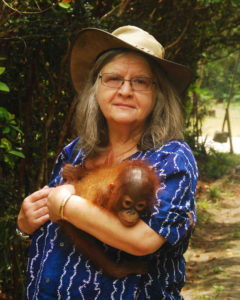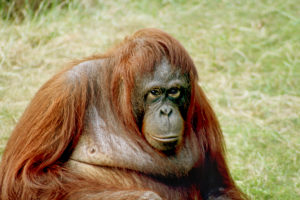Most of us enjoyed reading stories about Curious George, the mischievous monkey, and his friend, the Man in the Yellow Hat. But for one six-year-old with her first library book, Curious George created a defining moment—she would be an explorer and study primates.
Birute Mary Galdikas was born on May 10, 1946, while her Lithuanian parents were traveling to a new home in North America. She grew up in Canada, but moved later with her family to the United States. She earned anthropology degrees at UCLA.
While a graduate student there, she met the famous paleontologist Louis Leakey. She wanted to follow in the footsteps of two other women he mentored, Jane Goodall and Dian Fossey. But she wanted to study orangutans in Indonesia, a task that Leakey thought was more difficult. She was persistent, however, and Leakey warmed to the idea. In 1971, he found funding for her to begin her studies.
With her photographer husband, Galdikas set up a research station—named Camp Leakey—at the Tanjung Putting Reserve in Borneo, Indonesia. Orangutans are mostly solitary and they live in swampy forests, both factors that made her research difficult, but also important. Little was known about orangutans when she started working.
Like Goodall and Fossey, Galdikas’ patience and persistence paid off. The orangutans got used to her and accepted her observations. And what she learned changed our perceptions of the species. While adult males are highly solitary and competitive, females and young are less so. Females only give birth once every eight years, the longest interval between reproduction known in the animal world. The animals feed on more than 400 foods, taking advantage of whatever is available. They are highly intelligent, and researchers were able to teach individuals sign language.

Galdikas’ work has brought the ecology of orangutans to both scientists and the public. A cover story in National Geographic in 1975 cemented her prominence as an orangutan biologist. She remained in Borneo for 40 years studying orangutans, a record for one researcher observing one species at the same location. Although not as famous as Goodall and Fossey—partly, she believes, because she stayed rooted in her Borneo research camp—her work has had a major influence on our knowledge of and concern for orangutans. Her work has been featured repeatedly in National Geographic, in major newspapers, on television and in several film documentaries.
As the orangutans became popular, Gadikas’ work gained prominence. She has been awarded many honors for her work, including being the only foreign-born person to win Indonesia’s Kalataru Award, the country’s top prize for environmental work. In 1986, she and a group of supporters established the Orangutan Foundation International (OFI), headquartered in Los Angeles and with branches around the world. The foundation supports global efforts to study and protect wild orangutans. She still splits her time between the foundation’s headquarters and her research camp in Borneo.

She remains fundamentally concerned about the sustainability of orangutan populations in the wild. IUCN classifies the species as “critically endangered,” because of illegal hunting and habitat loss from illegal logging. Forest fires that ravaged Indonesia during the late 1990s had a major impact on orangutan habitat. In a 2000 interview with The New York Times, she said:
“I feel like I’m viewing an animal holocaust and holocaust is not a word I use lightly. The machine of extinction is grinding away. The destruction of the tropical rain forest in Borneo is accelerating daily. The consequences of this destruction for the orangutans will be final. And if orangutans go extinct in the wild, paradise is gone. And we’ll never have it again.”
She continues her research work not only to advance knowledge, but also to provide a steady presence for conservation in rural Borneo. Rural people need jobs that come from keeping the animals alive and the forests intact. Galdikas believes that “one of the best things that can happen to a forest is to have researchers there. They attract attention and get the government to enforce protections. Even if it is just a ‘paper park’ [where rules aren’t enforced very well] they can protect habitat, because developers are reluctant to do anything permanent, like create a plantation.”
So, she stays. And because she does, so do the orangutans. Curious George would be proud.
References:
Dreifus, Claudia. 200. Scientist at Work/Birute Galdikas; Saving the Orangutan, Preserving Paradise. The New York Times, March 21, 2000. Available at: https://www.nytimes.com/2000/03/21/science/scientist-at-work-birute-galdikas-saving-the-orangutan-preserving-paradise.html. Accessed May 7, 2018.
Nature. 2005. Pioneering Primatologist. PBS, February 13, 2005. Available at: http://www.pbs.org/wnet/nature/orphan-king-pioneering-primatologist/11410/. Accessed May 7, 2018.
Orangutan Foundation International. Dr. Birute May Galdikas. Available at: https://orangutan.org/about/dr-birute-mary-galdikas/. Accessed May 7, 2018.
